Mastering Kiteboard Footstraps for Ultimate Performance
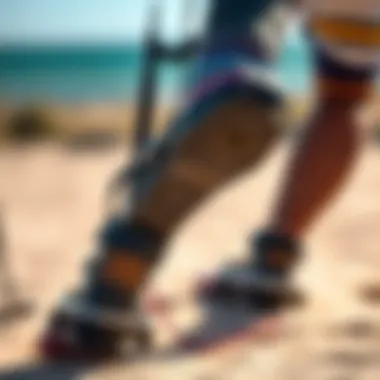
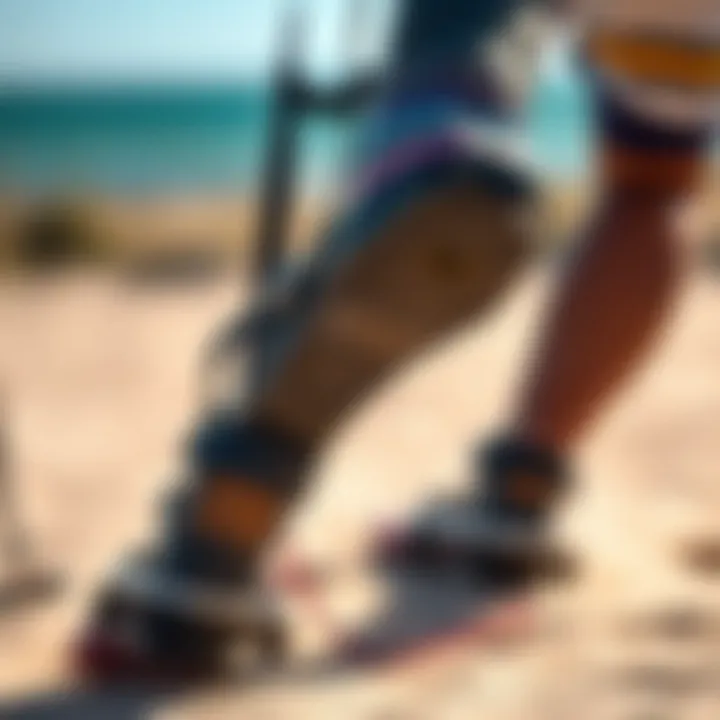
Intro
Kiteboarding, a thrilling blend of surfing and flying, relies heavily on equipment that facilitates both safety and performance. Among the critical components of this sport, footstraps play a vital role in determining how well you control the board. These straps, which secure your feet to the board, can make the difference between a smooth ride and chaotic crashes. Understanding their function, design, and how to select the right ones is essential for kiteboarders at any level.
In this guide, we'll dive deep into everything you need to know about footstraps. We’ll explore their impact on performance, comfort, and safety. Moreover, we’ll look at the different types of footstraps available, how their features can enhance your riding experience, and practical advice for selecting the right pair tailored to your needs.
Gear and Equipment
Footstraps are not simply an accessory; they are an integral part of your kiteboarding setup. Therefore, having the right gear is vital whether you are just starting out or are an experienced rider.
Essential Kiteboarding Gear for Beginners
If you're taking your first steps into the kiteboarding world, it's crucial to have the right basics. Apart from the kite and the board itself, your gear choice can significantly influence your initial experience.
- Footstraps: Look for adjustable straps that offer good support and comfort. Soft padding can make a big difference in those early learning sessions.
- Kite: A smaller kite can be more manageable, allowing you to learn how to control your movements without being overwhelmed.
- Board: A beginner board, typically wider, increases stability, giving newcomers the confidence to ride without fear of falling.
Choosing gear designed for beginners helps in reducing frustration and enhancing your enjoyment on the water.
Advanced Equipment for Experienced Riders
Once you're confident in your skills, it may be time to upgrade your gear to enhance performance. Experienced riders typically focus on how gear complements their riding style and preferences.
- Footstraps: Look for dual strap systems; they offer customizable adjustments for various foot sizes. Brands like Naish and Cabrinha offer designs that secure the foot well while allowing for quick entry and exit.
- Kite: Advanced riders might opt for a more robust kite that handles gusty winds and provides enhanced jumping capabilities.
- Board: A lighter, twin-tip board can improve performance drastically through sharper turns and quicker acceleration.
When choosing equipment, consider how the combination of your board and footstraps interacts with your riding style.
Techniques and Tips
Mastering footstraps doesn't just involve choosing the right gear; it’s also about how you use them. Proper technique can significantly affect your overall performance.
Safety Practices for Kiteboarding
Safety truely should be at the forefront of every kiteboarder's mind. . Before hitting the waves, remember the following:
- Wear a Life Jacket: Always have a flotation device for added safety.
- Check the Gear: Make sure that your harness, kite, and footstraps are in good condition before every session.
- Know the Area: Be aware of currents and potential hazards in the water, like rocks or shallow areas.
These practices not only protect you but also encourage others around you to stay safe while enjoying the sport.
Training Techniques to Improve Your Skills
As you become more skilled, consider practicing new techniques for better control and performance while using footstraps:
- Practice Your Velocities: Experiment with how your body weight shifts when you ride. This understanding will help you gain more control over your movements.
- Jumping: Gradual practices in adjusting your foot position before taking off can aid in smoother landings.
- Controlled Turns: Work on initiating turns while keeping your feet firmly in the straps. Practicing this in various wind conditions strengthens your agility.
Putting the time and effort into honing these skills can significantly elevate your kiteboarding experience.
Preamble to Kiteboard Footstraps
In the world of kiteboarding, every tiny element can influence your performance and overall enjoyment of the ride. Among these elements, footstraps hold a pivotal role that should not be underestimated. Without them, you'll find yourself in a precarious position, much like a ship without an anchor. Their function isn’t merely to hold your feet in place; they become a direct line of connection between you and the board, facilitating movement, control, and balance. This section sheds light on what footstraps are, their importance, and how they affect your kiteboarding experience.
Understanding Footstraps in Kiteboarding
Footstraps are a simple yet clever invention central to kiteboarding equipment. At their core, they are padded straps that attach your feet to the board. Think of them as the lifeline that gives you the leverage needed to navigate through wind and water, enhancing your ability to pull off tricks and maneuvers with finesse.
These straps come in a range of designs, materials, and levels of adjustability, all tailored to meet the diverse needs of riders. Understanding how to utilize them—aligning them correctly, adjusting for fit, and ensuring your comfort—can significantly set apart an amateur from an experienced kiteboarder. They can determine whether you’ll ride the waves smoothly or spend more time in the water than on your board.
Importance of Footstraps for Performance
The importance of footstraps in kiteboarding performance is akin to that of a good pair of tires for a race car. A solid setup doesn't just improve control and balance; it empowers the rider to execute tricks with precision. Properly secured footstraps ensure that riders can maintain their stance even in choppy waters or powerful winds. This is crucial, especially when attempting complex jumps or quick maneuvers.
Here are some key benefits that reinforce the significance of footstraps:
- Enhanced Stability: Footstraps act as a stabilizing force, enabling you to maintain your footing as conditions shift unpredictably.
- Control During Tricks: When you're in the air, having your feet firmly planted allows for a better approach and landing, maximizing your tricks’ effectiveness.
- Safety and Security: Properly adjusted footstraps reduce the risk of losing your board in the surf, providing peace of mind while riding.
Ultimately, footstraps are not just accessories; they are essential components of kiteboarding equipment that influence your overall performance. A well-chosen set can make the difference between a frustrating ride and an exhilarating experience on the waves.
Types of Kiteboard Footstraps
Footstraps are not just accessories in kiteboarding; they are crucial to a rider's control, comfort, and overall performance. The right footstraps can be the difference between mastering a jump or taking an unplanned plunge into the water. Understanding the various types of footstraps available is, therefore, imperative for anyone wishing to elevate their kiteboarding experience. Diving into the multiple options can help you choose the best fit for your riding style and body type, allowing you to navigate the waters with confidence.
Standard Velcro Footstraps
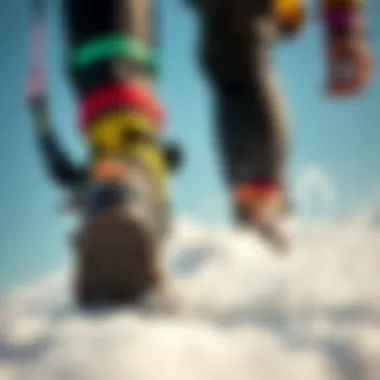
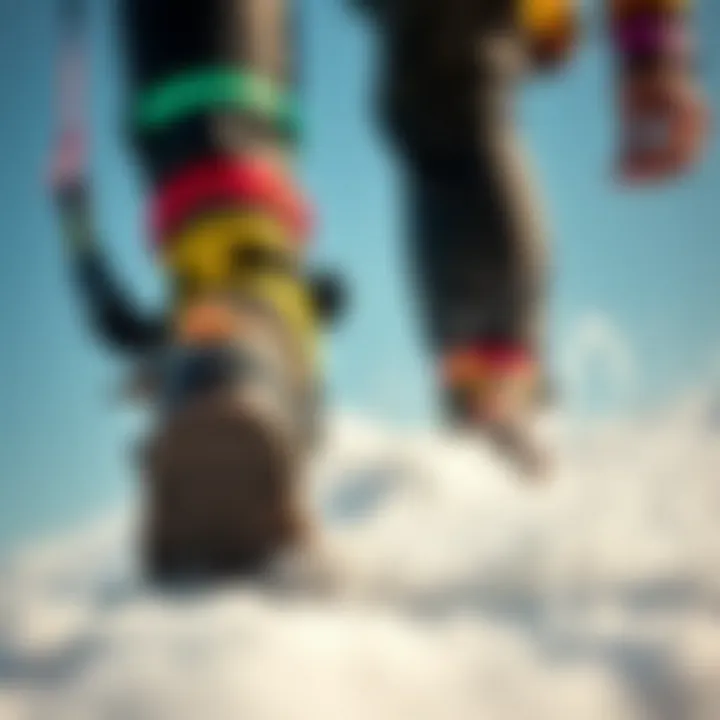
Standard Velcro footstraps are the tried-and-true option loved by many kiteboarders for their simple design and robust functionality. These footstraps consist of a durable fabric band that wraps around your foot and fastens securely with Velcro. They are typically adjustable, meaning you can tighten or loosen them to find that sweet spot of comfort. One significant benefit of Velcro straps is their quick adjustability. You can hop on and off your board in no time, making them particularly attractive for beginner kiteboarders who are still acclimating to the sport.
- Pros:
- Cons:
- Easy to adjust for different foot sizes
- Quick on and off features
- Generally affordable
- Velcro can wear out over time
- Might loosen during riding if not secured properly
If you're someone who values convenience and ease of use, standard Velcro footstraps might just be the way to go. However, remember to check the quality of the Velcro and the overall stitching, as these elements are crucial for longevity.
Neoprene Footstraps
Next up are neoprene footstraps, the soft touch in the realm of footstrap options. Made from a thick, cushioned material similar to that used in wetsuits, neoprene footstraps are designed with comfort in mind. They are especially forgiving on the skin, reducing the chances of chafing during long rides. Neoprene also provides a degree of stretch, ensuring that your feet are snug without feeling constricted.
- Pros:
- Cons:
- Excellent comfort, reducing chafing
- Good grip on the foot
- Durable against saltwater and UV exposure
- Generally pricier than Velcro options
- Can take longer to dry compared to other materials
For riders who prioritize comfort, especially during extended sessions, neoprene footstraps can be a game-changer. They allow you to focus on your tricks and maneuvers instead of worrying about your feet. But keep in mind that while they are built for comfort, their higher price point can be a deterrent for some.
Customizable Footstraps
For the kiteboarder who craves personalization, customizable footstraps offer an exciting avenue to truly make the gear your own. These straps come in various designs and allow riders to tweak not just the fit but also elements like padding thickness and the angle at which the foot is secured. Customizable footstraps provide a tailored experience, addressing specific needs based on individual riding styles and preferences.
- Pros:
- Cons:
- Fully adjustable to meet personal needs
- Variety of color and design options available
- Enhanced control for advanced tricks
- Can be more complex to set up
- Often on the pricier side
For those already proficient in kiteboarding, customizable footstraps can elevate your riding by fine-tuning the connection between your body and the board. Yet, with flexibility comes a learning curve, as one might need to experiment before finding the perfect setup.
Custom footstraps can extend not just your performance but also your enjoyment by allowing a level of personalization that standard options can't match.
Key Features to Consider
When perusing the world of kiteboarding, one aspect that should never be overlooked is the footstrap. The right footstraps can significantly enhance your overall performance and safety on the water. It’s not just about strapping your feet to the board; it’s about finding the perfect fit that will enable you to ride with confidence. Let’s dive into the features that matter most when choosing footstraps.
Materials and Durability
Choosing the right material for footstraps is paramount. You want something that stands the test of time, especially when facing the elements. Premium materials like nylon and polyester are commonly used due to their high resistance to UV rays and saltwater. They tend to be tougher than the average material and are less prone to wear and tear.
- Nylon: Lightweight and strong, this fabric can stretch slightly without losing its shape, providing a snug fit.
- Neoprene: Often found in more comfortable footstraps, neoprene offers a softer touch while still maintaining a solid grip.
Durability also ties into the stitching and reinforcements in the straps. Look for straps that have reinforced seams and double stitching. This attention to detail can mean the difference between a footstrap that lasts a single season versus one that could endure for several.
Padding and Comfort
Comfort is another key player. Kiteboarding can be intense, and you don't want discomfort to distract you from enjoying the ride. Well-padded footstraps help absorb impact from choppy waters and provide support to prevent fatigue during long sessions.
- Thick Padding: Straps that are generously padded contribute to overall comfort, allowing for longer ride times.
- Shape and Contour: Look for straps that contour to the shape of your foot. This ergonomic design can provide better control and efficiency when maneuvering through waves.
A note worth mentioning; try before you buy. If possible, put on the footstraps and give them a wiggle. The right feel can make a world of difference.
Adjustability and Fit
Finally, adjustability is crucial. Many riders will tell you, a perfect fit isn’t just a perk; it’s a necessity. Footstraps should offer easy adjustment mechanisms so that you can get your fit just right, whether you’re riding in flip-flops or heavy boots.
- Adjustable Straps: Look for designs that allow you to change the strap length quickly. This is especially handy if you're sharing equipment or changing riding styles.
- Secure Fit: Once you’ve adjusted them to your satisfaction, ensure they stay in place. Loose straps can lead to slips, which may turn into unfortunate spills.
Putting these features into consideration will undoubtedly enhance your kiteboarding experience. Finding the right pair of footstraps tailored to your needs can make all the difference in your time on the water.
Footstrap Configuration
Footstrap configuration plays a critical role in kiteboarding, influencing comfort, control, and safety on the water. Getting it right can make the difference between a smooth ride and a frustrating experience. A proper configuration ensures that the footstraps align well with the rider's body, allowing for better maneuverability and response to shifting winds and water conditions. Here, we dissect the essential components of footstrap configuration, focusing on their placement and angle, which are crucial for enhancing your riding experience.
Placement on the Board
When it comes to footstrap placement, it’s not just a matter of simply attaching them wherever it seems convenient. The location significantly affects how the rider engages with the board. Typically, footstraps are positioned above the board’s center, allowing for even weight distribution. A common mistake many beginners make is placing them too far forward or backward, which can lead to an awkward stance and hinder performance.
Here are a few key considerations for the correct placement:
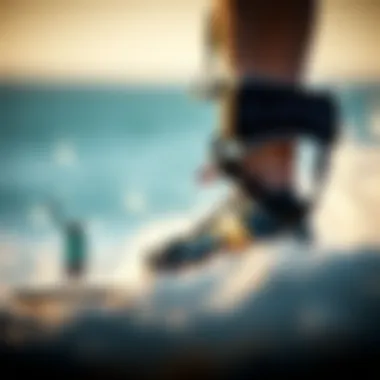
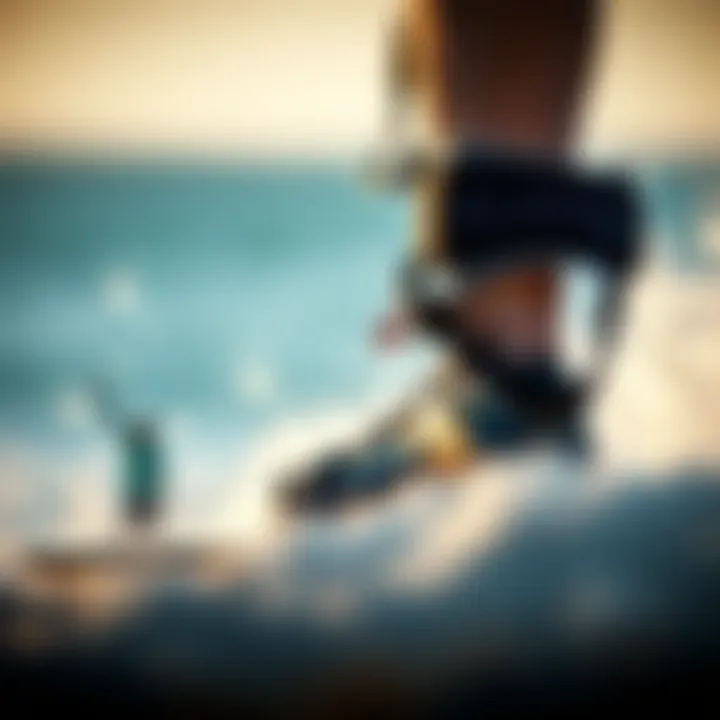
- Personal Comfort: Some riders prefer a wider stance for stability, while others might opt for a more narrow fit to enhance agility. It's essential to position the footstraps according to what feels most comfortable.
- Riding Style: Freestyle riders may benefit from a different placement compared to those focused on speed or jumping. Adjusting the straps nearer to the tail can provide better control for tricks, while a more centered position may enhance stability.
- Experimentation: Don’t be afraid to play around with the placement as it can significantly impact your ride. Sometimes, shifting just a few centimeters can yield remarkable differences in comfort and performance.
"Proper placement of footstraps can turn your kiteboarding session from good to great; it's all in the details."
Angle and Orientation
Next up is the angle and orientation of the footstraps, which can markedly affect how a rider interacts with the board as well. The ideal strap angle often depends on how an individual rides and what their physical attributes are. A few pointers to keep in mind:
- Foot Alignment: Adjustable footstraps allow for modifications to match the natural angle of your feet. This is crucial because an improper angle can result in discomfort, straining ankles, and potentially injury. Aim for a slight inward angle that aligns with your body's natural stance.
- Skill Levels: Newcomers might find it beneficial to set the straps parallel to the board initially, giving a more stable platform as they develop their skills. As confidence grows, adjusting to a slight angle can enhance maneuverability and responsiveness.
- Wind Conditions: During strong winds, a more angled setup can provide better control compared to flat configurations. Riders facing varying conditions should consider adjusting the angles to match the intensity of the wind and waves.
In sum, footstrap configuration is not simply a technicality but a foundational aspect of kiteboarding. Both placement and angle profoundly affect your riding capabilities and overall enjoyment on the water. Careful attention to these details not only enhances your skill but also ensures that each session is as rewarding as possible.
Selecting the Right Footstraps
Choosing the right footstraps is a cornerstone of achieving comfort and performance in kiteboarding. It’s not merely about picking any strap off the shelf; the decision can significantly influence your ride. Footstraps serve a dual purpose: they keep you connected to the board and help you maintain control even in the most unpredictable conditions. Selecting the correct pair hinges on multiple factors including body type, riding style, and environmental considerations. Each rider's experience is unique; therefore, understanding these elements can greatly enhance your comfort, safety, and overall enjoyment on the water.
Rider Body Type Considerations
Not every footstrap works for every body type. A rider's physique plays an essential role in determining the ideal strap. Heavier riders might require footstraps with more robust support to prevent any foot slippage during high-speed maneuvers. On the flip side, lighter riders could benefit from adjustable straps that offer a snug fit without unnecessary bulk.
For instance, riders with larger feet ought to look for straps with ample space and cushioning to avoid pinching or discomfort. Conversely, those with smaller feet might prefer narrower designs that allow for greater precision and responsiveness. Tailoring your selection to your unique anatomy ensures that you can tackle any wave or gust with confidence.
Riding Style Preferences
Riding style further complicates the footstrap choice. Are you a freestyle fanatic, carving sharp turns, or are you more into cruising at a steady pace? Freestyle riders need footstraps that provide quick release for safe landings and rotations; these often feature a thinner profile and can be adjusted easily.
If you lean towards speed and jumping, wider and more robust straps may be the way to go, delivering stability even during high-impact landings. Consider the type of moves you'll be executing. A strap that allows for easy back foot adjustments can be invaluable in tweaking your ride without stopping. Aligning your footstrap selection with your riding style unlocks the potential to perform at your best.
Environmental Influences
Let’s not overlook environmental conditions; they can heavily impact your footstrap choice. Riders often encounter different water and wind conditions. In choppy waters or high winds, a secure footstrap can provide additional grip, helping maintain balance. On the other hand, riders who frequently navigate calmer waters might prioritize comfort and adjustability over sheer grip.
The material of the footstrap is also important, considering conditions like UV exposure and saltwater corrosion. Some straps are specially designed with more durable materials, while others might lose effectiveness over time in harsh environments. Evaluating the elements can lead to a more informed decision that not only enhances performance but prolongs the lifespan of your equipment.
"Choosing the right footstrap isn’t just about aesthetics; it’s about making sure you ride safe and strong on the water."
In summary, selecting the right footstraps necessitates a careful consideration of one’s body type, riding style, and environmental factors. Context plays a pivotal role in making the most informed choice. The right footstraps not only improve performance but can also ensure a safer and more enjoyable kiteboarding experience.
Safety Considerations
When it comes to kiteboarding, safety isn't just a footnote, it’s a chapter that riders must take to heart. Kiteboarding offers thrills like few other sports can. However, with every twist and turn, there are inherent risks entrenched in the rush of gliding over waves. Footstraps play a crucial role in safety, directly impacting rider control and the likelihood of injury. Ensuring secure attachment to your board not only maximizes performance but also allows for swift response in dynamic conditions. Missteps can become dire, so understanding and embracing safety protocols is as essential as the gear itself.
Injury Prevention Strategies
Injury prevention strategies are vital to maintaining not just enjoyment but also longevity in kiteboarding. Footstraps that offer a snug, yet comfortable fit can greatly reduce the risk of destabilization. If your foot pops out unexpectedly, the chances of a nasty fall increase dramatically. Here are some practical approaches:
- Tailor Fit Adjustments: Make it a routine to adjust the footstraps to fit snugly before every session. If you're feeling loose, you're playing a dangerous game.
- Test Release Mechanisms: Some straps have quick release features. Familiarize yourself with how these function in case you need to set them loose quickly in an emergency.
- Wear Protective Footgear: Consider wearing booties or impact shorts. They can provide not only traction but also a buffer against possible injuries more serious than a stubbed toe.
- Educate Yourself: Attend clinics or workshops to learn proper riding technique. More knowledge translates to greater awareness and safer riding practices.
Assessment and keeping aware of problems before they can escalate is the linchpin of injury prevention. The rhyme of the sport calls for agility; therefore, staying connected to your equipment should not be an afterthought.
Check Before Riding
The ritual of checking your gear before hitting the water isn’t merely a suggestion; it’s a mandate. Much like a pilot runs through their checklist, taking that extra time to ensure your footstraps are in prime condition can save you from unwanted mishaps.
Before tossing your board in the surf, consider these pointers:
- Inspect for Wear and Tear: Look for frayed edges or loose stitching on your footstraps. If they’ve seen better days, it might be time to replace them.
- Check the Attachment Points: Ensure the footstraps are secured properly to the board. Loose straps can lead to catastrophic failures at an inopportune time, leading to collisions or more severe incidents.
- Adjustable Settings: If your footstraps are adjustable, double-check that they’re locked into position and not likely to slip during use. Try tugging at them to feel if they give some leeway.
- Stay Hydrated and Rested: Tired, dehydrated bodies may find it harder to react, increasing risk. A well-hydrated rider is a mindful rider.
"An ounce of prevention is worth a pound of cure."
Taking time to check your equipment is more than just a habit; it builds the foundation for epic sessions rather than epic fails. A few minutes could mean the difference between sailing smoothly and catching a wave that turns into a nasty wipeout.
Maintenance and Care of Footstraps
Keeping your footstraps in top shape is crucial for an enjoyable and safe kiteboarding experience. Regular maintenance helps ensure that they remain functional, comfortable, and free from wear and tear. Proper care not only extends the lifespan of your footstraps but also contributes to your overall performance on the water. Think of footstraps like the tires on a car; they need to be sturdy and well-maintained to ensure smooth sailing.
Cleaning and Inspection
Cleaning your footstraps should be a regular part of your routine. Sand, salt, and dirt can accumulate over time, potentially compromising their effectiveness. Start by rinsing them with fresh water after each session to remove salt and debris, which can cause the straps to deteriorate faster. A quick wipe with a soft cloth is often sufficient, but if they’re particularly dirty, consider using mild soap and water. Avoid harsh chemicals that could break down the material.
Inspection is equally important. Check for signs of wear, such as frayed edges or weakened straps. This is particularly crucial if you ride frequently in challenging conditions. If you notice any significant damage, replacing the footstraps sooner rather than later can prevent accidents and injuries.
"A stitch in time saves nine." Being proactive about footstrap maintenance can save you from bigger issues later on.
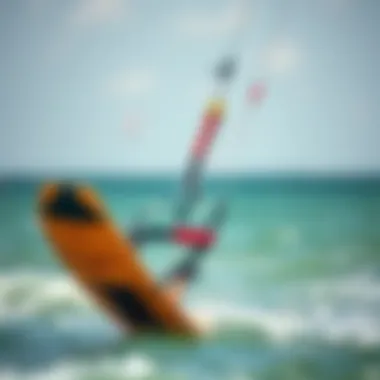
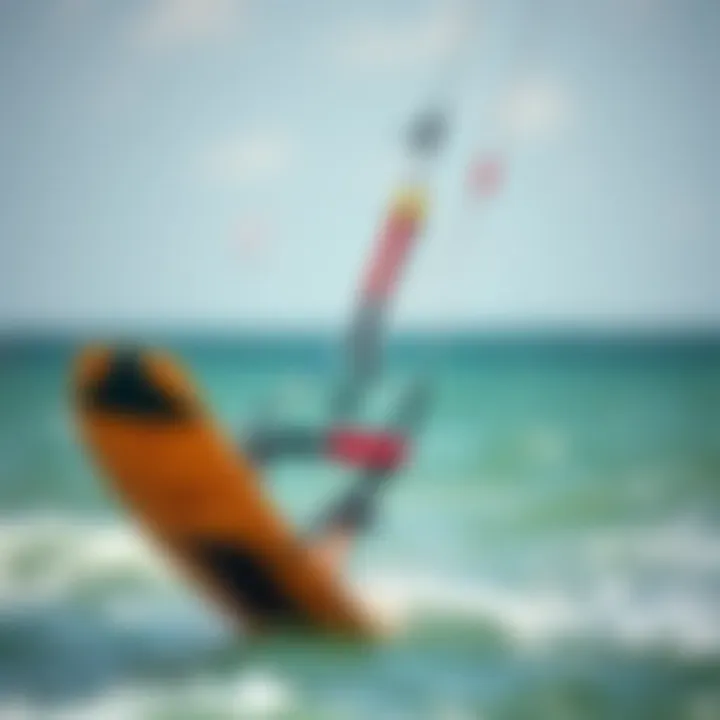
Storage Tips
Storing your footstraps correctly is another significant aspect of maintenance. After rinsing and drying them thoroughly, avoid leaving them in direct sunlight or damp places. Excessive heat or moisture can warp or weaken the materials. Instead, consider these storage tips:
- Keep them in a cool, dry place: A closet or storage bin works well.
- Avoid folding them tightly: Lay them flat if you can, which helps maintain their shape.
- Use a dedicated bag: Consider a canvas or mesh bag specifically for your kiteboarding gear, which allows airflow and prevents mildew.
By following these steps, your footstraps will thank you later with greater durability and dependability when you hit the waves. Proper maintenance and storage not only keeps your gear in functional shape but also enhances your overall kiteboarding experience.
Innovations in Footstrap Technology
As kiteboarding evolves, so do the technologies that support it. Innovations in footstrap design directly impact how riders experience the sport, affecting everything from comfort to control. These advancements are not just mere upgrades but rather thoughtful adaptations to the challenges riders face on the water.
Recent Developments
In recent times, several brands have introduced innovative materials and designs to the footstrap landscape. For instance, lightweight carbon fiber composites have started to appear, providing increased strength while significantly reducing weight. This shift allows for a more agile performance, making enthusiastic riders feel as if they're flying at the end of their lines.
Another notable advancement is the incorporation of smart technology in footstraps. Some models now feature built-in pressure sensors that help riders monitor their stance and pressure distribution. As a result, this data can be relayed to an app, providing insights to help improve balance during rides. It’s almost like having a personal coach with you as you glide across the waves.
Moreover, manufacturers have paid more attention to ergonomics. Multi-density foams are now often molded specifically to the contour of the foot. This tailoring results in less fatigue and greater comfort during extended sessions. For many, spending a full day on the water means avoiding hotspots that can lead to pain. This new approach to design is a game-changer—no one wants to cut a session short due to discomfort.
Future Trends
Looking ahead, it seems that the trajectory of footstrap technology will keep integrating with wearable tech and AI. Imagine a future where footstraps could not only analyze performance data but also provide real-time feedback on riding posture or suggest adjustments to stance for optimal performance. While the whole concept might sound like something out of a sci-fi movie, the rapid pace of technological development in sports gear makes it entirely plausible.
Sustainability is also likely to become a substantial focus. As riders grow increasingly aware of environmental issues, brands may turn to eco-friendly materials without compromising performance. Footstraps made from recycled materials while maintaining the quality that enthusiasts demand could become mainstream in the near future.
Lastly, customization will play a critical role. The convenience of selecting or even custom-fitting footstraps to personal preferences may change the way riders approach their gear. Just as one size doesn’t fit all in clothing, riders will demand straps that hug their feet just right, offering both comfort and control.
"Advancements in kiteboarding gear are not just about innovation; they're about enhancing the entire experience on the water."
Comparison of Popular Brands
When it comes to kiteboarding, choosing the right footstraps can make or break your riding experience. Several brands stand out in the crowded market, each bringing something unique to the table. A well-informed comparison of these brands helps kiteboarders—whether they are beginners or experienced riders—make decisions that align with their needs and preferences. This section outlines how understanding the different offerings from popular brands can enhance comfort, boost performance, and ensure safety on the water.
Brand A Overview
Brand A is well-regarded for its innovative designs and commitment to quality. Their footstraps feature a balance of comfort and performance, making them a popular choice among riders.
Key Features:
- Material Quality: Brand A uses high-grade materials that resist wear and tear, essential for tackling the harsh conditions typically faced in kiteboarding.
- Ergonomic Design: The footstraps are contoured to the shape of the foot, providing an improved grip and better energy transfer when maneuvering.
- Adjustability: They come with multiple adjustment points, allowing for a customized fit which is crucial for different foot sizes and riding styles.
Brand B Overview
Brand B sets itself apart from the competition with its focus on lightweight construction without compromising durability. The brand’s mantra revolves around the idea of enhancing performance through minimalism.
Key Features:
- Lightweight Materials: The use of advanced, lightweight fabrics allows for agile movements, which is perfect for freestyle riders.
- Non-Slip Straps: These footstraps come with a specially designed surface to ensure that feet stay firmly in place, giving riders the confidence they need to push limits.
- Color Variety: Riders can choose from a wide range of colors, enabling personalization that appeals to self-expression on the water.
Brand Overview
Brand C shines in the customization department, offering footstraps that can be tailored to individual rider preferences. They cater to a diverse range of users, recognizing that each kiteboarder has unique needs.
Key Features:
- Custom Options: Brand C allows customers to select different materials, padding thicknesses, and even the strap's curve.
- Robust Adjustability: The straps are designed with extensive adjustability, making them suitable for different styles, from light cruising to extreme tricks.
- Sustainability Focus: Committed to eco-friendly practices, this brand utilizes recycled materials in its products, appealing to environmentally conscious riders.
Choosing the right footstrap can mean the difference between a lackluster day on the water and riding with confidence. Every element from material to adjustability impacts your overall experience.
In summary, when comparing brands, those considerations—material quality, design features, and customization options—should guide your decision-making. By diligently exploring these aspects, kiteboarders can find footstraps that not only meet their demands but elevate their performance.
Culmination
When wrapping up a深入 examination of kiteboard footstraps, it’s key to recognize their significant role in both performance and rider comfort. The numerous types of footstraps available each offer their own unique advantages, allowing for personalized experiences on the water. Whether you're a novice just finding your footing or a seasoned rider looking to push boundaries, making informed decisions about footstraps is crucial.
Summation of Footstrap Importance
Footstraps are not merely accessories; they are a critical component that influences performance, stability, and safety during rides. Having the right fit and type of footstraps can transform how a kiteboarder navigates across water. Proper footstraps ensure that riders can maintain control, which translates to better tricks and maneuvers. Additionally, they protect the rider by providing a secure grip, reducing the risk of slips or falls that could lead to injury. A truly well-fitted strap feels like an extension of the rider’s body, allowing them to connect more intimately with their board and the elements.
Some key benefits include:
- Enhanced stability leads to improved confidence for beginners.
- Personalized footstraps can cater to individual riding styles, improving overall experience.
- Safety features inherent in some designs help prevent accidents during high-speed maneuvers.
Final Thoughts for Enthusiasts
As the kiteboarding world evolves, so too do the technologies and materials behind footstraps. Enthusiasts should remain vigilant, ensuring they invest in footstraps that resonate with their personal riding style as well as their physical attributes. The nuances of fit, padding, and adjustability can make all the difference.
Ultimately, the right footstrap isn’t just about comfort; it’s about enhancing the entire kiting experience. Whether you're carving through waves or catching air, choosing the optimal footstraps will elevate not only performance but the sheer joy of the ride. Keeping abreast of new innovations and actively seeking out the best fit could mean the difference between a mediocre day on the water and an exhilarating adventure. So gear up, find those perfect straps, and let the wind guide you.



